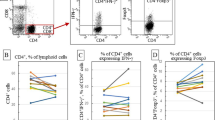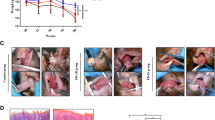Abstract
Purpose
Immune impairment is hypothesized to be one of the reasons for the dismal treatment response in oral cancers. This study evaluates the immune impairment in patients with primary squamous cell carcinoma of the oral cavity and the effect of IL-2 administration on restoration of the immune responses.
Methods
T-cell populations were enumerated by flow cytometry; T-cell function by MTS proliferation assay to PHA and anti-CD3, expression of T-cell signaling proteins ZAP-70, TCRζ, p56lck, PKC and CD-ε in T cells with and without activation by IL-2 using Western blot and statistical analysis using X 2 test and bivariate correlation analysis in 112 patients.
Results
Reduction in proportion of CD3+ and CD4+ T lymphocytes, decrease in the CD4+/CD8+ T-cell ratios, reduced lymphocyte transformation to PHA and anti-CD3 and reduced production of interleukin-2(IL-2) were observed in the patient group. Lymphocyte proliferation to anti-CD3 could be augmented in 59.5% of non-responders by IL-2 (range 10–90%) along with significant increase in the expression of TCR-ζ and ZAP-70, CD3ε, p56 LCK and PKC to varying degrees. The expression of ZAP-70 and TCR-ζ was found to be closely related to treatment response and could be augmented by IL-2 in terms of proliferation and IL-2 production.
Conclusions
The results suggest IL-2 to augment T-cell responses in a proportion of oral cancer patients with poor response to conventional therapy. IL-2 immunotherapy can be thought of as a personalized adjuvant therapy for oral cancer following the in vitro identification of IL-2 responders using the expression of TCRζ and ZAP-70 as biomarkers.





Similar content being viewed by others
References
Balaram P, Vasudevan DM (1983) Quantitation of Fc receptor bearing T lymphocytes (TG and TM) in oral cancer. Cancer 52:1837–1890
Balaram P, Kumari TV, Vasudevan DM (1984) Leucocyte adherence inhibition assay (LAI) in cancer of the oral cavity. Eur J Cancer Clin Oncol 20:891–897
Balaram P, Pillai MR, Abraham T (1987) Immunology of premalignant and malignant conditions of the oral cavity. II. Circulating immune complexes. J Oral Pathol 16:389–391
Baniyash M (2004) TCR ζ-chain downregualtion: curtailing an excessive inflammatory immune response. Nat Rev Immunol 4:675–687
Blanchard N, Bartolo VD, Hivroz C (2002) In the immune synapse, ZAP-70 controls T-cell polarization and recruitment of signaling proteins but not formation of the synaptic pattern. Immunity 17:389–399
Buggins AGS, Milojkovic D, Arno MJ, Lea NC, Mufti GJ et al (2001) Microenvironment produced by acute myeloid leukemia cells prevents T cell activation and proliferation by inhibition of NF-kB, c-Myc, and pRb pathways. J Immunol 167:6021–6030
Cheriyan VT, Krishna SM, Kumar A, Jayaprakash PG, Balaram P (2009) Signaling defects and functional impairment in T-cells from cervical cancer patients. Cancer Biother Radiopharm 24(6):667–673
Choi SH, Chung EJ, Whang DY, Lee SS, Jang YS (1998) Alteration of signal transducing molecules in tumour infiltrating lymphocytes and peripheral blood lymphocytes from human colorectal carcinoma. Cancer Immunol Immunother 45(6):299–305
De Paola F, Ridolfi R, Riccobon A, Flamini E, Barzanti F, Granato AM, Mordenti GL, Medri L, Vitali P, Amadori D (2003) Restored T-cell activation mechanisms in human tumour-infiltrating lymphocytes from melanomas and colorectal carcinomas after exposure to interleukin-2. Br J Cancer 88:320–326
Dooms H, Wolsjegel EK, Lin P, Abbas AK (2007) Interleukin-2 enhances CD4 + T cell memory by promoting the generation of IL-7Ralpha expressing cells. JEM 204(3):547–557
Fisher RI, Rosenberg SA, Fyfe G (2000) Long-term survival update for high-dose recombinant interleukin-2 in patients with renal cell carcinoma. Cancer J Sci Am 6:S55–S57
Gottschalk RA, Corse E, Allison JP (2010) TCR ligand density and affinity determine peripheral induction of Foxp3 in vivo. JEM 207(8):1701–1711
Jemal A, Tiwari RC, Murray T et al (2004) Cancer statistics. CA Cancer J Clin 54(1):8–29
Kouttab NM, Maizel AL (1987) Interleukin-2 -Its role in the regulation of T cell proliferation. Cancer Bull 39:51–60
Kulkarni DP, Wadia PP, Pradhan TN, Pathak AK, Chiplunkar SV (2009) Mechanisms involved in the downregulation of TCR ζ chain in tumor versus peripheral blood of oral cancer patients. Int J Cancer 124(7):1605–1613
Kurt RA, Urba WJ, Smith JW, Schoof DD (1998) Peripheral T-lymphocytes from woman with breast cancer exhibit abnormal protein expression of several signaling molecules. Int J Cancer 78:16–20
Levey DL, Srivastava PK (1996) Alterations in T cells of cancer-bearers: whence specificity. Immunol Today 17:365–368
Mc Kallip R, Li R, Ladisch S (1999) Tumor gangliosides inhibit the tumor-specific immune response. J Immunol 163:3718–3726
McDermott DF, Regan MM, Atkins MB (2006) Interleukin-2 therapy of metastatic renal cell carcinoma: update of phase III trials. Clin Genitourin Cancer 5(2):114–119
Murali PS, Somasundaram R, Rao RS, Fakih AR, Gangal SG (1987) Interleukin-2 mediated regulation of mitogen-activated T cell reactivity from different lymphoid sources in patients with squamous cell carcinoma of the oral cavity. J Oral Pathol Med 18:327–332
Nakagomi H, Petersson M, Magnusson I, Juhlin C, Matsuda M, Stedt HM, Taupin JL, Vivier E, Anderson P, Kiessling R (1993) Decreased expression of the signal-transducing ζ chains in tumor-infiltrating T-cells and NK cells of patients with colorectal carcinoma. Cancer Res 53:5610–5612
Pacheco-Castro A, Martín-Fernández JM, Millán R, Sanal O, Allende L, Regueiro JR (2004) Toward gene therapy for human CD3 deficiencies. Hum Gene Ther 14(17):1653–1661
Pappas J, Wolfson AD, Jung WJ, Olezak EL, Helm CW, Freedman RS, Tsygankov AY, Platsoucas AD (2009) Differential expression of CD3ζ message and protein in tumor infiltrating lymphocytes from solid tumor specimens and malignant ascites from patients with ovarian carcinoma. Anticancer Res November 29(11):4673–4682
Pillai MR, Balaram P, Nair MK (1987) Role of immune response in the prognosis of carcinoma of the uterine cervix: can in vitro analysis provide better framework for more effective management? Tumori 78:87–93
Pillai MR, Balaram P, Abraham T, Padmanabhan TK, Nair MK (1988) Natural cytotoxicity and serum blocking effects in malignant cervical neoplasia. Am J Reprod Immunol Microbiol 16:159–162
Pillai MR, Balaram P, Kannan S, Sudha L, Nalinakumari KR, Hareendran NK, Nair MK (1990a) Interferon activation of latent natural killer cells and alteration in kinetics of target cell lysis: clinical implications for oral precancerous lesions. Oral Surg Oral Med Oral Pathol 70:458–461
Pillai MR, Balaram P, Chidambaram S, Padmanabhan TK, Krishnan Nair M (1990b) Development of an immunological staging system to prognosticate disease course in malignant cervical neoplasia. Gynaecol Oncol 37:200–205
Rabinowich H, Reichert TE, Kashii Y, Bell MC, Whiteside TL (1998) Lymphocyte apoptosis induced by Fas ligand-expressing ovarian carcinoma cells: implications for altered expression of TcR in tumour-associated lymphocytes. J Clin Invest 101:2579–2588
Reichert TE, Day R, Wagner E, Whiteside TL (1998) Absent or low expression of the chain in T cells at the tumor site correlates with poor survival in patients with oral carcinoma. Cancer Res 58:5344–5347
Riss TL, Moravec RA (1992) Comparison of MTT, XTT, and a novel tetrazolium compound MTS for in vitro proliferation and chemo sensitivity assays. Mol Biol Cell 3(Suppl):184a
Scully C (2010) Cancers of the oral mucosa treatment & management. Medscape drugs diseases and procedures. http://emedicine.medscape.com/article/1075729-treatment 2010
Sebzda E, Mariathasan S, Ohteki T, Jones R, Bachmann MF, Ohashi P (1999) Selection of the T cell repertoire. Annu Rev Immunol 17:829–874
Shibuya TY, Nugyen N, McLaren CE, Li KT, Wei WZ et al (2002) Clinical significance of poor CD3 response in head and neck cancer. Clin Cancer Res 8:745–751
Singer A, Adoro S, Park JH (2008) Lineage fate and intense debate: myths, models and mechanisms of CD4- versus CD8-lineage choice. Nat Rev Immunol 8:788–801
Taylor DD, Edwards RP, Case CR, Taylor CG (2004) Modulation of CD3-zeta as a marker of clinical response to IL-2 therapy in ovarian cancer patients. Gynecol Oncol 94(1):54–60
Acknowledgments
We thank Indian Council of Medical Research New Delhi, India for financial support.
Author information
Authors and Affiliations
Corresponding author
Rights and permissions
About this article
Cite this article
Cheriyan, V.T., Thomas, C. & Balaram, P. Augmentation of T-cell immune responses and signal transduction proteins in oral cancer patients: potential for IL-2-mediated immunotherapy. J Cancer Res Clin Oncol 137, 1435–1444 (2011). https://doi.org/10.1007/s00432-011-1012-2
Received:
Accepted:
Published:
Issue Date:
DOI: https://doi.org/10.1007/s00432-011-1012-2




